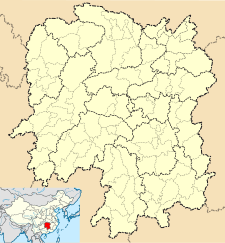Fuyan Temple
| Fuyan Temple | |
|---|---|
福严寺 | |
.jpg/440px-Shanmen,_Fuyan_Temple_(Hunan).jpg) The Shanmen of Fuyan Temple. | |
| Religion | |
| Affiliation | Buddhism |
| Sect | Chan Buddhism |
| District | Nanyue District |
| Prefecture | Hengyang |
| Province | Hunan |
| Location | |
| Country | China |
| Prefecture | Hengyang |
| Geographic coordinates | 27°16′11″N 112°42′35″E / 27.269641°N 112.709789°E / 27.269641; 112.709789 |
| Architecture | |
| Style | Chinese architecture |
| Founder | Nanyue Huisi |
| Date established | 567 |
Fuyan Temple (simplified Chinese: 福严寺; traditional Chinese: 福嚴寺; pinyin: Fúyán Sì) is a Buddhist temple located on Mount Heng, in Nanyue District of Hengyang, Hunan, China.[1] It has been designated as a National Key Buddhist Temple in Han Chinese Area in 1983.
History
The construction of the temple, originally named "Bore Chan Temple" (般若禅寺) or "Bore Temple" (般若寺), was initiated in 567 by Nanyue Huisi during the Six Dynasties period (222-589).[1][2][3]
During the Zhenguan period (627-649) of Tang dynasty (618-907), Emperor Taizong of Tang gave 50 volumes of Buddhist scriptures to the temple. In 713, in the 2nd year of Xiantian period, Nanyue Huairang came here and served as its abbot.[2][3]
During the Taiping Xingguo period of Song dynasty (960-1279), Emperor Taizong of Song inscribed and honored the name "Fuyan Temple", and the name has been retained today.[1][2][3]
In 1870, in the 9th year of Tongzhi period of Qing dynasty (1644-1911), the local government reconstructed the temple.[2][3]
In 1983, it has been categorized as a National Key Buddhist Temple in Han Chinese Area.[2][3]
Architecture
Fuyan Temple has more than 10 buildings and halls, the well-preserved buildings include the shanmen, the Hall of Holy Emperor of Mount Heng, the Mahavira Hall, the Abbot's Room, the Dharma Hall, the Hall of Guru, the Buddhist Texts Library, the Meditation Hall, and the Huayan Pavilion.[2]
Hall of Holy Emperor of Mount Heng
The Hall of Holy Emperor of Mount Heng is the third hall of the temple for the worship of the Holy Emperor of Mount Heng (岳神).[2][4]
Ginkgo trees
The temple has four old ginkgo trees. One of them is already 1400-years-old.[2][5][4]
Mahavira Hall
The Mahavira Hall is the fourth hall in the temple. Statues of Horizontal Three-Life Buddha are enshrined in the hall, namely Sakyamuni (middle), Amitabha (right) and Bhaisajya (left). The statue of Horizontal Three-Life Buddha are enshrined in the center with Eighteen Arhats lining up on both sides.[2][4]
Gallery
-
The Zhike Hall.
-
The Meditation Hall.
-
The Mahavira Hall.
-
The Hall of Holy Emperor of Mount Heng.
References
- ^ a b c Zhang Yuhuan (2012), p. 247–248.
- ^ a b c d e f g h i [衡阳] 魅力南岳 福严寺:“六朝古刹,七祖道场”. hunan.voc.com.cn (in Chinese). 2017-04-28.
- ^ a b c d e 南岳四大名蓝 天下法院——湖南福严寺. iFeng (in Chinese). 2011-08-18.
- ^ a b c 【首届湖南文物解读大赛】福严寺. rednet.cn (in Chinese). 2016-11-15. Archived from the original on 2018-03-05. Retrieved 2018-03-04.
- ^ 银杏叶黄福严寺,满地尽带“黄金甲”. hyqss.cn (in Chinese). 2016-11-18.
Further reading
- Zhang Yuhuan (2012). "(Chapter Twelve) Eminent Monks' Tracks: Legend of Generations of Buddhist Masters and Their Accommodation" 第十二章《高僧的足迹:历代大师与所在寺院的传说》. 《图解中国佛教建筑》 [Illustration of Buddhist Architecture in China] (in Chinese). Beijing: Contemporary China Publishing House. ISBN 978-7-5154-0118-8.

.jpg/440px-Zhike_Hall,_Fuyan_Temple_(Hunan).jpg)
.jpg/440px-Meditation_Hall,_Fuyan_Temple_(Hunan).jpg)
.jpg/440px-Mahavira_Hall,_Fuyan_Temple_(Hunan).jpg)
.jpg/440px-Hall_of_Holy_Emperor_of_Mount_Heng,_Fuyan_Temple_(Hunan).jpg)